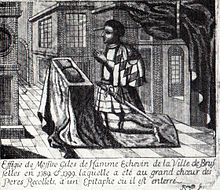|
Drapery Court of Brussels  The Drapery Court (French: Gilde Drapière[1] or Tribunal de la Draperie, Dutch: Lakengilde)[2] also called the Chamber of Commerce in the eighteenth century, was one of the oldest and most influential institutions of the City of Brussels during the Ancien Régime and was abolished during the French occupation of Brussels.  History and institutionThe Drapery Court, whose origins go back to the 12th century, was above all a judicial court[3] and a chamber of commerce which was originally intended to regulate the trade and manufacture of sheets and to check their quality. The Gilde was led by two judges called Deans (French: Doyens)[4] who were assisted by eight assessors called The Eight (French: les Huit, Dutch: De Acht, ) or the Octovirs. During the Angevin regime, the Deans and The Eight were appointed intendants and aldermen of the chamber of commerce. Until the revolution of 1421 they were all chosen among the Seven Noble Houses of Brussels and after, one Dean and four of The Eight were chosen from among the Guilds.[3] This Court sat three times a week on Tuesdays, Thursdays, and Saturdays. In the fifteenth century the Court named three valets to seal the sheets of the cloths whose quality it controlled, as well as two receivers, five controllers and a cloth sealer on of the ones on sale on the Grand-Place at the Halle aux Pains. It also named the weigher of the wool and the measurer of the potash (intended to wash the wools). ConfusionThe Drapery Court, which was a kind of commercial court, should not be confused with the Drapers' Guild.[5] While most of the judges who belonged to this tribunal had nothing to do with the trade of clothiers, they were, indeed, chosen among the Noble Houses, not able to exercise any profession or trade, and among the members of the Guilds belonging to various corporations.[6] See also
Bibliography
References
AuthorityContent in this edit is translated from the existing French Wikipedia article at fr:Gilde drapière de Bruxelles; see its history for attribution. |